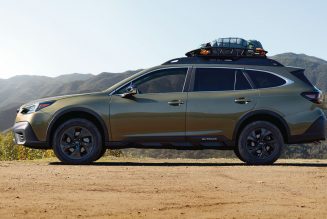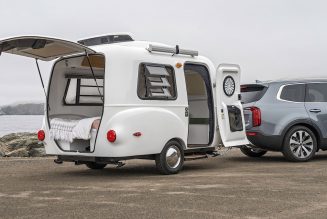The Outback has inspired imitators, but none has ever come close to this wagon/quasi-SUV’s success. After a couple months with the 2020 Subaru Outback Onyx 2.4 XT we’re driving for a year, we have a better idea of how it compares to the midsize two-row SUVs it competes against. So how good is this SUV-ified wagon’s interior practicality compared with an SUV? Keep reading to find out.
How the Outback Is a Match for SUVs
Part of why MotorTrend has consistently liked Subaru Outbacks for years is their combination of SUV practicality offered at a lower price than some competitors. That’s still mostly true for the 2020 Outback, including our one-year Onyx 2.4 XT tester. Let’s start with the Outback’s cargo area. Every Outback starting with the $31,305 Premium trim with a package gets a power liftgate. Open it up, and you have 32.5 cubic feet of space. That’s more spacious than the Chevrolet Blazer and Nissan Murano but falls short of the Ford Edge and Honda Passport.
The Subaru’s cargo floor is conveniently low, of course, thanks to the fact that this is a lifted wagon. There’s no underfloor storage, unfortunately, but two levers easily fold down the rear seats from the cargo area. One of the cargo area’s best features is a sliding cargo privacy cover that offers a taller detent—perfect for those road trips when someone inevitably overpacks. Rear visibility is reduced in this setting, but the setup would still be manageable while you drive from home to hotel/campsite. And as you press the liftgate’s close-and-lock button to head for a pit stop, the feature provides peace of mind that your stuff will be out of sight.
In the back seat, the Outback feels spacious for two. There’s even a ton of headroom, a fact possibly helped by the fact that a panoramic roof isn’t available on this Subaru at any price. The seat recline latch is located at the bottom of the outboard seat backs, and every Outback except for the base model gets two rear-seat USB ports. Spring for the $34,455 Outback Limited 2.5 and higher to add heated rear seats, again speaking to the Subaru’s value argument compared to some of its competition.
We’re focusing on interior practicality here, but two of the Subaru’s biggest strengths are its easy-to-use retractable crossbars and the standard AWD, which we’ve found effective off-road.
How SUVs Beat the Outback in Functionality
Despite all the exterior styling details Subaru has added to make the Outback look rugged, the automaker can only do so much to change ride height. And although the Outback has a more commanding seating position than a car, it doesn’t sit as high as an SUV. If a higher ride height is part of an SUV’s appeal for you, though, the Outback does a passable job.
Beyond fitting into the midsize “carlike SUV” segment, the Outback is a crossover in another sense, too. The pricing is so reasonable that Subaru’s consumer site compares the wagon to compact and midsize SUVs. Regardless of what you compare the midsize Outback against, some SUVs do a better job of making room for the middle-seat passenger with a flatter drivetrain hump.
The Outback is also longer than most of its competitors. If you’re considering a Forester, that spacious Subaru is 9.2 inches shorter, which should make it easier to park. Even though the Outback’s rear visibility is better than that of many of its competitors, rear-seat headrests that fold down out of the way (as they do on a Volvo V60, Chevrolet Blazer, and a few other vehicles) would make it that much better.
Image, of course, is arguably the biggest reason some might still stick with an SUV over the Outback, a lifted wagon that outperforms some SUVs off-road. Over the last couple decades, wagons have transitioned from the go-to choice for families to a niche choice for those who want to be different. So far, although I wish the Outback had a higher seating position, the Subaru more than earns its place in the midsize two-row SUV segment. Buyers brave enough to try this lifted wagon should mostly be pleased with how its interior functionality compares to an SUV.










